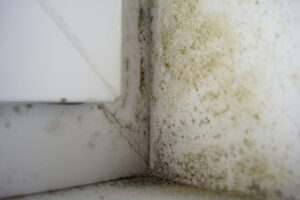Mold is more than just an unsightly issue; it can damage your home and impact your health. With Chicago’s fluctuating weather and humidity levels, mold is a concern every homeowner should be prepared for. Catching mold early is key to minimizing its impact. Here’s how you can stay ahead of potential mold problems.

Recognizing Mold Hotspots in Your Home
Mold thrives in environments that are damp, dark, and poorly ventilated. Be proactive by regularly checking these common areas:
- Basements: Look for moisture from leaks or condensation on walls and floors.
- Bathrooms: Keep an eye on grout lines, shower curtains, and corners prone to dampness.
- Kitchens: Check under sinks and around appliances for hidden leaks.
- Windowsills: Watch for condensation buildup that can lead to mold.
- Attics: Ensure proper ventilation and inspect for roof leaks that might foster mold.
Spotting Visible Mold Growth
Mold often reveals itself through visual clues. Be on the lookout for:
- Color Changes: Mold can appear in shades of black, green, white, or gray.
- Surface Textures: Fuzzy, slimy, or powdery patches may indicate mold.
- Persistent Stains: Water stains on walls or ceilings might signal underlying mold growth.
Using Your Nose: Musty Odors as a Warning Sign
A persistent, musty smell is often the first indicator of hidden mold. If you detect these odors in specific areas, such as basements, attics, or near HVAC vents, further investigation is necessary.
Controlling Humidity Levels
High humidity creates the perfect conditions for mold to thrive. Use a hygrometer to monitor indoor humidity and aim for a range between 30% and 50%. Use dehumidifiers in damp areas like basements and bathrooms, and ensure proper ventilation.
Identifying and Fixing Water Issues
Water leaks are a leading cause of mold. Inspect your home regularly for:
- Dripping Faucets or Pipes: Even small leaks can create a mold problem.
- Roof Damage: Missing shingles or poorly sealed areas can let water in.
- Condensation: Check windows, pipes, and HVAC systems for moisture buildup.
Address any water issues promptly to prevent mold from taking hold.
Checking Your HVAC System
Your home’s heating and cooling systems can harbor mold if not properly maintained. Regularly:
- Inspect Ducts: Look for visible mold or musty smells.
- Clean or Replace Filters: Dirty filters can trap moisture and encourage mold.
- Ensure Proper Drainage: Check drip pans for standing water.
Preventive Maintenance Tips
Regular upkeep can go a long way in preventing mold:
- Clean Your Gutters: Prevent water from pooling near your home’s foundation.
- Seal Cracks and Openings: Keep moisture out with properly sealed windows and doors.
- Ventilate Your Home: Use exhaust fans in bathrooms and kitchens to reduce humidity levels.
Call in the Professionals
If you suspect mold but can’t find it, or if the affected area seems extensive, it’s time to bring in experts. First Choice Inspectors use advanced tools like thermography to locate hidden mold and provide a detailed report with recommendations for remediation.
Mold is a problem that’s easier to prevent than to fix. By staying vigilant and addressing issues early, you can keep your Chicago home safe and healthy. Contact First Choice Inspectors today at 773-429-9711 for a comprehensive mold inspection and expert advice on maintaining a mold-free home.